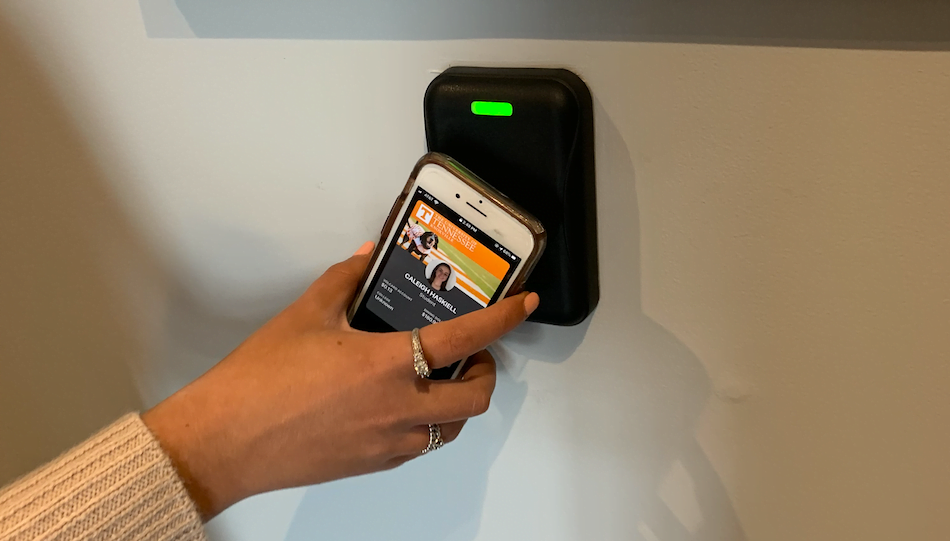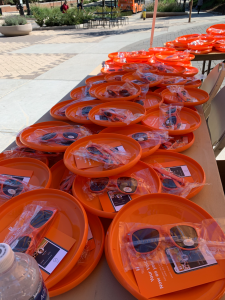
Vermont, San Francisco and Tennessee share their mobile ID experience
By Jeff Koziol, business development manager, campus software partner at Allegion
You’ve heard about the mobile movement that’s expected to surge in popularity on higher education campuses across the country. Many have raved about the seamless user experience and the enhanced credential security, but how do you know if mobile is the right solution for your campus? And when is it time to consider the transition?
Three unique schools of different sizes, geographies and security needs share insights about their decisions to transition from magnetic stripe cards to mobile student ID cards. The University of San Francisco, the University of Tennessee, Knoxville, and the University of Vermont all share their experiences, the value they expect to receive and advice for their peers.
Mark McKenna, Director of the CATcard Service Center at the University of Vermont:
“We were motivated by our own CATcard team to move away from the mag stripe credential. We had been pursuing the contactless chip technology readers for the past year after some misuse of our mag stripe cards. Around that time, the student IDs in Apple Wallet became a possibility. Our new readers were NFC-ready, so it was a no brainer for us. We wanted to go with that added security, and the user convenience was a super bonus.”
Jason Rossi, Director of campus card and security systems at the University of San Francisco:
“We have a comprehensive campus card program just like many universities do, and we like our campus card program. But every campus card program comes with one necessary evil, and that’s the friction of producing cards and getting them to people. There’s a lot of administrative resources involved in that. The mobile credential gives us all of the benefits that we have in our campus card program but removes that one bit of friction.”
Mike Henderson, VolCard technology supervisor at the University of Tennessee, Knoxville:
“Students had been requesting a smart phone solution for years. The card office had also been pushing for the solution as it is more secure and will reduce their work load, especially in the fall. We utilized a top down approach and got buy-in from our senior vice chancellor, Chris Cimino. Once we had that support, everything else fell into place.”
McKenna, University of Vermont:
“We worked with CBORD and Apple for three or four months to make the changes required in the CBORD CS Gold system, ironing out the different technology pieces that needed to be put in place. We ran beta testing with about 20 people around campus for another couple months. At that stage in the game, we were feeling confident that everything was working well. We had already moved most of our stuff away from the mag stripe, so it was just validating that the Apple credential worked at the locations that we already converted. We did a lot of beta testing up front and it was probably one of the smoothest beta tests I’ve ever done in 20 years of being in the card industry.”

Informational material for the mobile credential initiative at the University of Tennessee, Knoxville.
Rossi, University of San Francisco:
“There were two parts to it: Number one was getting the requisite software in place. Number two was installing new hardware where we didn’t have contactless already or upgrading the firmware on existing contactless hardware. It was technically easy, but due to the volume we were dealing with, it was complex. It was routine to go to several hundreds of readers and do firmware updates, but there were still a lot of them out there to touch.”
Henderson, University of Tennessee, Knoxville:
“As we transitioned from iClass to MIFARE DESFire EV1, we had to replace over 4,000 readers across campus. This change was necessary so the mobile credential and new DESFire card could be accepted by the readers. As the first CBORD school to go live with the Apple solution, we had to work through all of the stopgaps along the way.”
McKenna, University of Vermont
“We have received nothing but positive feedback from our student population, and even our faculty and staff. The students love it for the dining services. They always have their phone with them, so it makes it very easy for them to do their meal transactions or get in and out of their res hall.
"Since launching in mid-October, we have almost 3,000 participants with the program. We have well over 250,000 transactions, with 15% of transactions conducted using a student ID in Apple Wallet.”
Since launching in mid-October, we have almost 3,000 participants with the program. We have well over 250,000 transactions, with 15% of transactions conducted using a student ID in Apple Wallet.”
Henderson, University of Tennessee, Knoxville
“Students are embracing it! Since launching on October 14, we have over 6,600 unique credentials and 500,000 transactions from those patrons.”
McKenna, University of Vermont:
“We anticipate our orientation this summer will look a little bit different. In past years, we always requested the photos upfront, printed the IDs and did a distribution. We’re trying to reengineer our orientation process for the summer so that if a student submits a photo, we should be able to ask if they have the iPhone. Students with iPhones have the option of putting it in Apple Wallet. We may still require having at least an ID badge on campus. But instead of printing a $5 chip card, I can print a 50-cent piece of plastic with a student photo on the front.”
Rossi, University of San Francisco:
“It’s a paradigm shift because we’re changing the entire delivery of the campus card experience into something that’s self-serve. Even if students submitted their photo in advance and we printed it in advance, there were still distribution locations. It’s really changing that process to a bring-your-own-credential model. They login through single sign-on just like they do with every other bit of business on campus. Now the card is simply another one of those online services.”
McKenna, University of Vermont:
“I think there will be less sharing of credentials. People are pretty willing to forfeit their piece of plastic to somebody else to let them get in their res hall or use their meal plan. Letting someone take your thousand-dollar phone or Apple Watch will probably not happen – or it will at least reduce the number of times that happens. When you elect to turn on your Apple credential, we deactivate the chip in the physical card so that it can’t be passed onto somebody else.”
"The biggest benefit we are seeing so far is that students and staff are far less likely to lose their phone or watch. This is also going to allow us in the future to get rid of the mag stripe and barcode from the plastic cards."
Rossi, University of San Francisco:
“We do see this as a way to secure the credential since it is protected by multi-factor authentication, whereas a card is not. The security component was a factor in our decision to use mobile student IDs.”
Henderson, University of Tennessee, Knoxville:
“We feel the mobile credential is very secure. The biggest benefit we are seeing so far is that students and staff are far less likely to lose their phone or watch. Another thing that this is going to allow us to do in the future is get rid of the mag stripe and barcode from the plastic cards.”
McKenna, University of Vermont:
“People love the convenience of it. A lot of people signed up right off the bat. We turned on the website and sent out emails around 8:00 a.m. When I was in dining services, a student told me he had already signed up and used some of the features – that was at 8:05 a.m.”
Rossi, University of San Francisco:
“It’s still new, but we had 100 testers for months prior to the launch. All of the feedback has been positive.”
Henderson, University of Tennessee, Knoxville:
“All of the feedback has been positive. Students and staff are embracing the new technology.”
McKenna, University of Vermont:
“If you’re on mag stripe, you have to move someplace. The contactless technology is definitely the direction to go. If you have not been moving away from mag stripe and getting ready for mobile credentials, don’t get blown away by the sticker shock. Part of that is just to get rid of the mag stripe technology, which needs to be done anyways.”
"When getting ready for mobile credentials, don’t get blown away by the sticker shock. Part of that is just to get rid of the mag stripe technology, which needs to be done anyways.”
Rossi, University of San Francisco:
“No two universities look the same. Organizationally, we are very different from each other. Ask pointed questions and see if it will fit your business needs. It may not be for everyone, but it certainly is a fit for USF and our business needs.
For example, we have campuses throughout California. Our year-zero launch has been in our law school, school of education and branch campuses. These groups are extraordinarily difficult to get cards to because their courses could be hundreds of miles away.
The old process to get cards to these locations required students to upload their photo online, and then everything smart stopped there. From that point, a person in San Francisco printed the card on a commercial printer, put it into a FedEx envelope and mailed off to someone else in California. Then it was collected by another person, given to a professor, and then picked up by the student. Talk about friction! Our year-zero launch has the biggest impact operationally and on the student experience. Now the student can self-provision.
"It’s really about looking at one’s own operations and pain points and finding the best tool to address it. For us it’s by far a mobile credential.”
It’s really about looking at one’s own operations and pain points and finding the best tool to address it. For us it’s by far a mobile credential.”
Henderson, University of Tennessee, Knoxville:
“Jump on in. The early adopters have overcome the majority of the start-up issues, so the path is paved for a smooth conversion for any other schools.”
Allegion is excited to help universities across the country achieve frictionless student experiences via contactless student IDs in Apple Wallet. Contact Allegion today to learn more about the company's mobile solutions or speak with an expert about the mobile movement on your campus.




